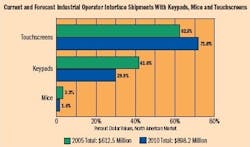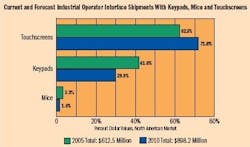Touchscreen fingerprints are everywhere
Touchscreens have displaced other input devices used on operator interface terminals in recent years, says VDC analyst Jake Millette. Input devices have evolved from single switches, to keypads or keyboards, and now touchscreens. Millette says keypads still are used widely today. They might be the lone method of input on some terminals, or might be used in conjunction with touchscreens. Overall, however, the use of keypads is declining.
Touchscreens provide an easy-to-use graphic interface for data or command inputs, and dramatically reduce the need for a mouse. Touchscreens occupy less space than a keypad, providing space savings, and cost savings for the enclosure.
Resistive touchscreens accounted for nearly 85% of the North American operator interface terminal market in 2005, says the study, attributing the dominance of this technology to its cost-effectiveness and reliability.
Capacitive touchscreens gained slight market share since 2003, but still account for only 5% of that market. This type of touchscreen is known to be highly durable, but is more expensive than resistive touchscreens and cannot be used with gloves.
Other underlying technologies such as infrared and near-field imaging are used in some terminals, but generally are less capable of surviving harsh environments or are too costly, concludes the study. Among these, only those using infrared technology account for an appreciable share (9.0%) of shipments.


